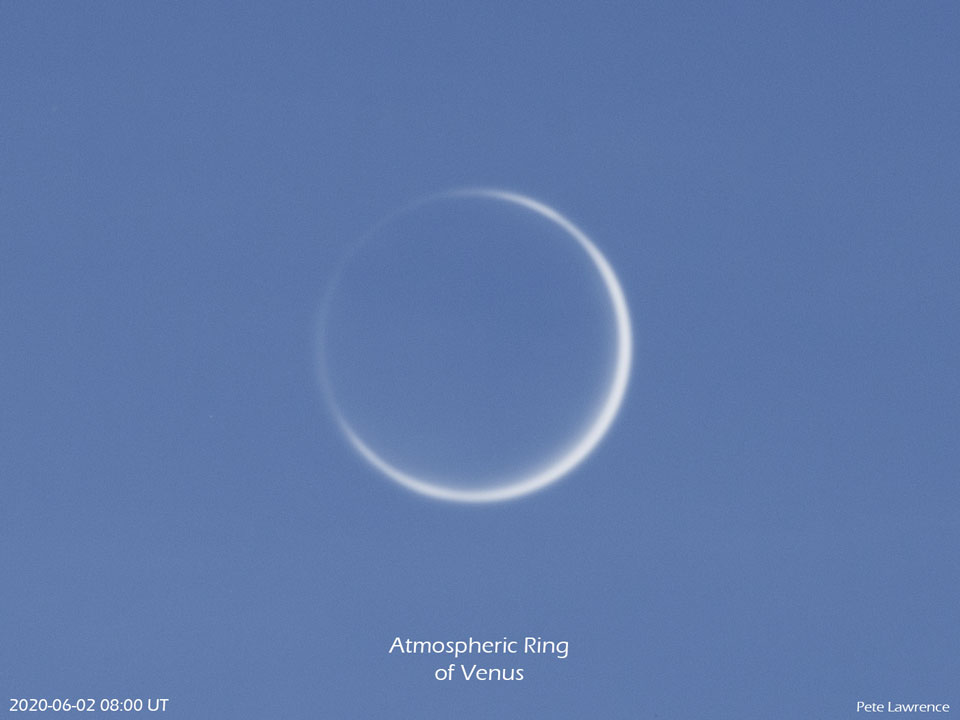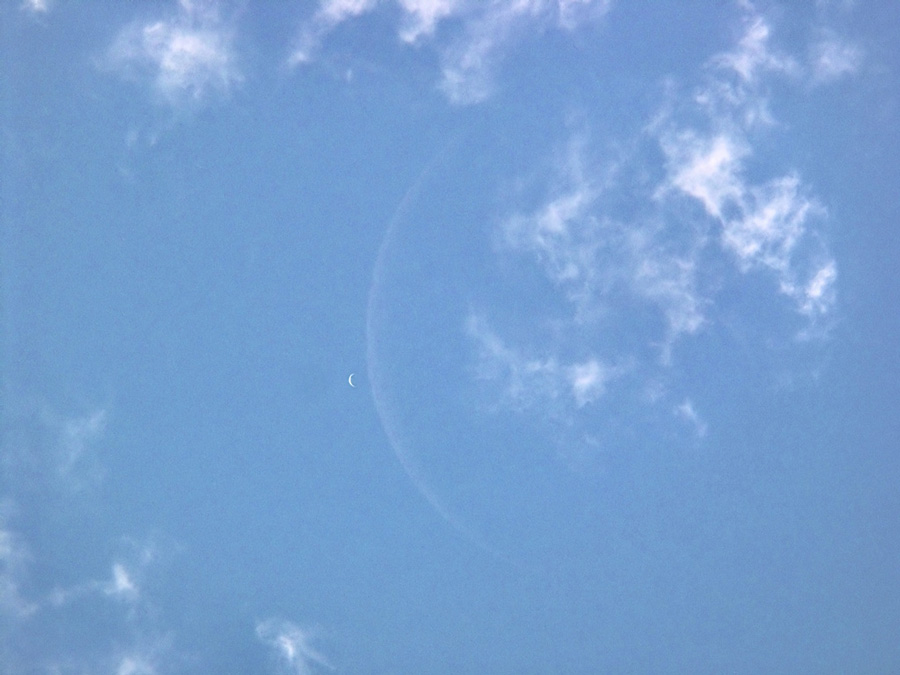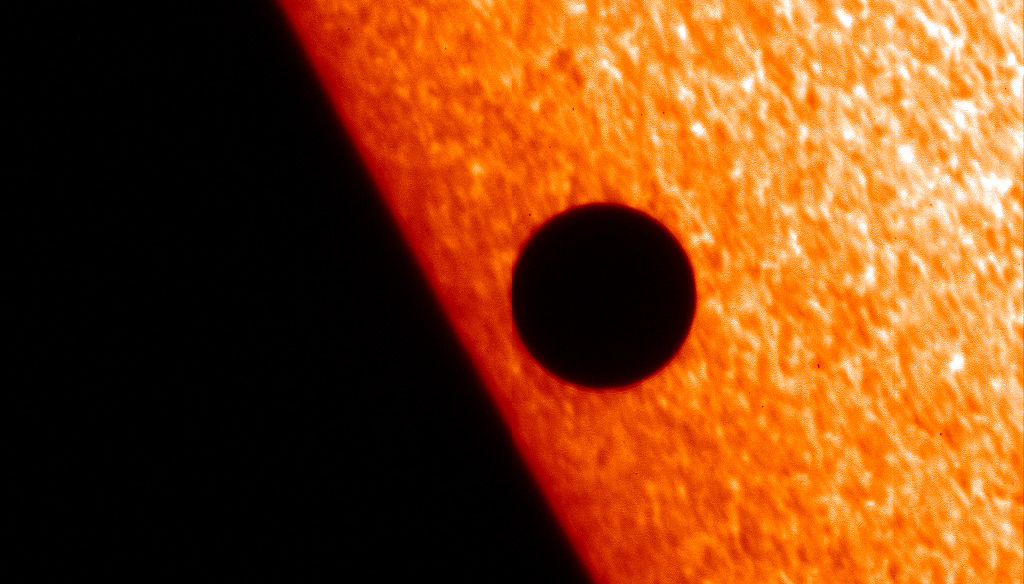Comments and questions about the
APOD on the main view screen.
-
shaileshs
- Science Officer
- Posts: 112
- Joined: Mon Mar 13, 2017 8:14 pm
Post
by shaileshs » Mon Jun 08, 2020 4:20 am
I wonder if there is/was any satellite/shuttle that was in a perfect position and angle near Venus where it's cameras would see Venus blocking full Sun behind it causing a ring around it the way we see it during solar eclipses ?
-
Ann
- 4725 Å
- Posts: 13842
- Joined: Sat May 29, 2010 5:33 am
Post
by Ann » Mon Jun 08, 2020 4:49 am
Venus and the Moon can both be seen as crescents in the Earth's sky (when Venus and the Moon are located between the Earth and the Sun). The crescent of Venus, of course, is much smaller, but also much brighter (per square unit) than the crescent of the Moon. That is because Venus is much farther away from the Earth than the Earth's own Moon is (obviously), but also because Venus is much, much more reflective than the Moon, so that it reflects back much, much more of the Sunlight it receives.
But Venus can be seen as a full circle, not just a crescent, because of sunlight scattering in the thick atmosphere of Venus.
Ann
Color Commentator
-
Donald Pelletier
- Ensign
- Posts: 32
- Joined: Mon Apr 21, 2008 11:53 pm
- Location: Valleyfield
-
Contact:
Post
by Donald Pelletier » Mon Jun 08, 2020 7:07 am
A ring around Mercury? Really? How is that possible? There is no thick atmosphere on this planet.
-
JohnD
- Tea Time, Guv! Cheerio!
- Posts: 1593
- Joined: Wed Feb 16, 2005 2:11 pm
- Location: Lancaster, England
Post
by JohnD » Mon Jun 08, 2020 10:07 am
To say that a transit of Venus or Mercury involves a "Ring of Fire" is unnecessarily hyberbolic, and forces a descriptive term beyond its useful range.
The Ring of Fire, and Bailey's Beads, seen in Lunar Eclipses, occur because of the concidence of apparent Lunar and Solar diameters seen from Earth. They look to be the same, but variance in the Lunar distance means that the Ring and the Beads may or may not appear at a given eclipse. This is not true of Venusian or Mercurian transits.
The atmospheric ring of Venus is fascinating! The photographer must have needed great skill to get those shots! Is it possible that the clear skies and sharp sight of ancient astronomers could have seen it?
-
Ann
- 4725 Å
- Posts: 13842
- Joined: Sat May 29, 2010 5:33 am
Post
by Ann » Mon Jun 08, 2020 10:43 am
Donald Pelletier wrote: ↑Mon Jun 08, 2020 7:07 am
A ring around Mercury? Really? How is that possible? There is no thick atmosphere on this planet.
I'm baffled too. How can Mercury display a ring of fire during its transit of the Sun?
Ann
Color Commentator
-
gkaplan
Post
by gkaplan » Mon Jun 08, 2020 10:49 am
The inferior conjunction of Venus last week, when Venus passed about a half degree north of the Sun, is the closest to the Sun between 2000 and 2050 that was not a transit. It was just outside the range of dates when a transit can occur.
-
orin stepanek
- Plutopian
- Posts: 8200
- Joined: Wed Jul 27, 2005 3:41 pm
- Location: Nebraska
Post
by orin stepanek » Mon Jun 08, 2020 11:55 am

- th.jpg (4.59 KiB) Viewed 10890 times
picture taken from computer images!
I think it is kinda like when Mercury crosses the face of the sun there is sunligh that lights uo the edge of the dark side of the planet! something like the dawn and dusk! I bet Chris could give a better answer

Orin
Smile today; tomorrow's another day!
-
CHRIS2332
Post
by CHRIS2332 » Mon Jun 08, 2020 1:19 pm
How can this occur?
From Earth Venus is too tiny to cover the face of the sun.
Right?
-
orin stepanek
- Plutopian
- Posts: 8200
- Joined: Wed Jul 27, 2005 3:41 pm
- Location: Nebraska
Post
by orin stepanek » Mon Jun 08, 2020 1:54 pm
CHRIS2332 wrote: ↑Mon Jun 08, 2020 1:19 pm
How can this occur?
From Earth Venus is too tiny to cover the face of the sun.
Right?
That's not what happened! As per APOD---
Venus did not pass directly in front of the Sun -- the complete atmospheric ring was caused by sunlight refracting through Venus' thick atmosphere.
Orin
Smile today; tomorrow's another day!
-
Cousin Ricky
- Science Officer
- Posts: 466
- Joined: Mon Aug 26, 2013 4:08 pm
- Location: St. Thomas, U.S. Virgin Islands (+18.3, -64.9)
Post
by Cousin Ricky » Mon Jun 08, 2020 3:16 pm
This image is beautiful!
-
shaileshs
- Science Officer
- Posts: 112
- Joined: Mon Mar 13, 2017 8:14 pm
Post
by shaileshs » Mon Jun 08, 2020 3:29 pm
shaileshs wrote: ↑Mon Jun 08, 2020 4:20 am
I wonder if there is/was any satellite/shuttle that was in a perfect position and angle near Venus where it's cameras would see Venus blocking full Sun behind it causing a ring around it the way we see it during solar eclipses ?
I'm surprised no one has any answer/comment on my query. Normally by now (after 12 hours) I see 2-3 responses at least. I guess people are busy resuming work on Monday..
-
johnnydeep
- Commodore
- Posts: 3232
- Joined: Sun Feb 20, 2011 8:57 pm
Post
by johnnydeep » Mon Jun 08, 2020 3:41 pm
Ann wrote: ↑Mon Jun 08, 2020 10:43 am
Donald Pelletier wrote: ↑Mon Jun 08, 2020 7:07 am
A ring around Mercury? Really? How is that possible? There is no thick atmosphere on this planet.
I'm baffled too. How can Mercury display a ring of fire during its transit of the Sun?
Ann
Yeah, doesn't make much sense to me either. But I did find this pic that sort of shows an orange ring around mercury during a solar transit. But perhaps that's just an optical artifact and not a real phenomenon?
--
"To B̬̻̋̚o̞̮̚̚l̘̲̀᷾d̫͓᷅ͩḷ̯᷁ͮȳ͙᷊͠ Go......Beyond The F͇̤i̙̖e̤̟l̡͓d͈̹s̙͚ We Know."{ʲₒʰₙNYᵈₑᵉₚ}
-
JohnD
- Tea Time, Guv! Cheerio!
- Posts: 1593
- Joined: Wed Feb 16, 2005 2:11 pm
- Location: Lancaster, England
Post
by JohnD » Mon Jun 08, 2020 3:53 pm
I can't remember what it is called, but there was a problem in the 18/19th century with noting exactly when the edge of the disc of either Venus or Mercury touched the rim of the Sun. This had great importance for calculating their orbits. The effect was optical and to do with diffraction, of light at the planets and in the optics. Can anyone remind me of this?
John
-
JohnD
- Tea Time, Guv! Cheerio!
- Posts: 1593
- Joined: Wed Feb 16, 2005 2:11 pm
- Location: Lancaster, England
Post
by JohnD » Mon Jun 08, 2020 3:55 pm
-
CHRIS2332
Post
by CHRIS2332 » Mon Jun 08, 2020 4:40 pm
CHRIS2332 wrote: ↑Mon Jun 08, 2020 1:19 pm
How can this occur?
From Earth Venus is too tiny to cover the face of the sun.
Right?
Where is the sun in relation to Venus here; off the screen?
-
johnnydeep
- Commodore
- Posts: 3232
- Joined: Sun Feb 20, 2011 8:57 pm
Post
by johnnydeep » Mon Jun 08, 2020 5:17 pm
Cool. Aka "the shadow bridge effect". Despite reading that article I still don't quite understand what's happening optically. Is it just the overlapping fuzziness of the edges of approaching objects effectively magnifying the opacity?
--
"To B̬̻̋̚o̞̮̚̚l̘̲̀᷾d̫͓᷅ͩḷ̯᷁ͮȳ͙᷊͠ Go......Beyond The F͇̤i̙̖e̤̟l̡͓d͈̹s̙͚ We Know."{ʲₒʰₙNYᵈₑᵉₚ}
-
RJN
- Baffled Boffin
- Posts: 1673
- Joined: Sat Jul 24, 2004 1:58 pm
- Location: Michigan Tech
Post
by RJN » Mon Jun 08, 2020 6:35 pm
Today's APOD has been corrected -- on the main NASA APOD page -- to say that the bright ring around Venus is caused by diffraction rather than atmospheric refraction. I apologize for the oversight. I thank Michel Duval for pointing this out over email. Papers of his about this effect can be found here:
https://ui.adsabs.harvard.edu/abs/2005J ... D/abstract
and here:
http://articles.adsabs.harvard.edu/full ... .111..149D .
As stated in these papers, diffraction is also the cause of the "black drop effect", and so that effect and this brightening effect are related.
As cited in the APOD text, it is common for any of a number of bright rings around an object passing angularly close to the Sun (or any bright background object) to be referred to as a "ring of fire". This need not be associated with the atmosphere that an occluding object might possess -- for example the Moon shows a "ring of fire" during an annular solar eclipse, but the Moon does not possess a thick atmosphere.
- RJN
-
MarkBour
- Subtle Signal
- Posts: 1377
- Joined: Mon Aug 26, 2013 2:44 pm
- Location: Illinois, USA
Post
by MarkBour » Mon Jun 08, 2020 8:31 pm
Mark Goldfain
-
neufer
- Vacationer at Tralfamadore
- Posts: 18805
- Joined: Mon Jan 21, 2008 1:57 pm
- Location: Alexandria, Virginia
Post
by neufer » Mon Jun 08, 2020 8:32 pm
RJN wrote: ↑Mon Jun 08, 2020 6:35 pm
Today's APOD has been corrected -- on the main NASA APOD page -- to say that the bright ring around Venus is caused by diffraction rather than atmospheric refraction. I apologize for the oversight. I thank Michel Duval for pointing this out over email. Papers of his about this effect can be found
here and
here.
It would be nice if Michel Duval presented papers by
OTHERS about this being a "
diffraction effect".
- Mark me as a skeptic

The darkest umbra during a Lunar Eclipse is
NOT totally black thanks to a "
ring of fire" around the Earth due to
atmospheric refraction plus Rayleigh scattering. This ~2º of light bending into the umbra is similar to what Venus's thicker atmosphere is accomplishing on its outer side in today's APOD.
Last edited by
neufer on Mon Jun 08, 2020 10:35 pm, edited 1 time in total.
Art Neuendorffer
-
heehaw
Post
by heehaw » Mon Jun 08, 2020 9:40 pm
I seem to recall that early attempts to measure the size of the solar system via transit of Venus from Tahiti were messed up by Venus having its dense atmosphere, causing difficulty in being sure of the time of e.g. first contact.
-
neufer
- Vacationer at Tralfamadore
- Posts: 18805
- Joined: Mon Jan 21, 2008 1:57 pm
- Location: Alexandria, Virginia
Post
by neufer » Mon Jun 08, 2020 10:49 pm
heehaw wrote: ↑Mon Jun 08, 2020 9:40 pm
I seem to recall that early attempts to measure the size of the solar system via transit of Venus from Tahiti were messed up by Venus having its dense atmosphere, causing difficulty in being sure of the time of e.g. first contact.
Fuzzy resolution and solar limb darkening are mostly to blame for the black-drop effect.
Diffraction effects may contribute a lttile to this
fuzzy resolution but...
the warm turbulent atmosphere in the solar direction is more likely the culprit.
Art Neuendorffer
-
JohnD
- Tea Time, Guv! Cheerio!
- Posts: 1593
- Joined: Wed Feb 16, 2005 2:11 pm
- Location: Lancaster, England
Post
by JohnD » Tue Jun 09, 2020 8:43 am
Posting two links to the same article as I posted doesn't contribute, neufer!
Where are your usual sideways looks at this?
Speaking of sideways, diffraction is an effect that occurs at edges. The disc we see of a planet in transit has edges, but in reality the light passes surfaces with a wide radius, not a slit, but this effect is just as real:
https://www.physicsclassroom.com/class/ ... iffraction
-
neufer
- Vacationer at Tralfamadore
- Posts: 18805
- Joined: Mon Jan 21, 2008 1:57 pm
- Location: Alexandria, Virginia
Post
by neufer » Tue Jun 09, 2020 11:47 am
JohnD wrote: ↑Tue Jun 09, 2020 8:43 am
Posting two links to the same article as I posted doesn't contribute, neufer!
Where are your usual sideways looks at this?
T. S. Eliot: "Immature poets imitate; mature poets steal."
(Who woulda thunk I'm the mature one

)
JohnD wrote: ↑Tue Jun 09, 2020 8:43 am
Speaking of sideways, diffraction is an effect that occurs at edges. The disc we see of a planet in transit has edges, but in reality the light passes surfaces with a wide radius, not a slit, but this effect is just as real:
https://www.physicsclassroom.com/class/ ... iffraction
https://sites.google.com/site/slitteranswer/ wrote:
- How many sheets could a sheet slitter slit
if a sheet slitter could slit sheets 
The slitter question...
First of all we need to clear something up; and that little 'something' is the use of the word 'if' - the reason being that sheet slitters CAN slit sheets, so there's no 'if' about it. Sheet Slitter machines DO exist, so unless a sheet slitter is experiencing some sort of terrible mechanical malfunction then you can rest assured that a sheet slitter can indeed slit sheets. Sheet slitters are expensive machines and businesses wouldn’t buy them to slit their materials if they in fact couldn’t slit sheets.
So with that little slop of mud cleared away from our metaphorical wind-sheilds we can proceed with trying to come up with an answer to that annoying question ‘How many sheets could a sheet slitter slit if a sheet slitter could slit sheets?’. There is an answer to this question, of course there is an answer, we’re talking about a real machine that performs a real function in real businesses. But (and I’m sorry if you feel I’ve led you astray) I can’t give you the answer without knowing the following essential variables:
- What material is being slit?
How thick is the material being slit?
What tension does the material need to be at when slit?
Does the material being slit have an adhesive coating?
How fast is the slitter being run at when slitting the sheets?
What type of slitting is being used to slit the sheets? Is it razor, shear or crush-cut slitting?
So with the answers to the above questions it would be fairly easy to answer the question ‘How many sheets could a sheet slitter slit if a sheet slitter could slit sheets?’. Unless of course you’re asking how many sheets could be slit in the useful life span of a slitter machine (rather than how many sheets could be slit in any single job run) in which case the answer is roughly ‘very very many’, slitter machines are very robustly built and last for may years if maintained properly.
Art Neuendorffer
-
JohnD
- Tea Time, Guv! Cheerio!
- Posts: 1593
- Joined: Wed Feb 16, 2005 2:11 pm
- Location: Lancaster, England
Post
by JohnD » Tue Jun 09, 2020 12:16 pm
OLE!
 Atmospheric Ring of Venus
Atmospheric Ring of Venus



